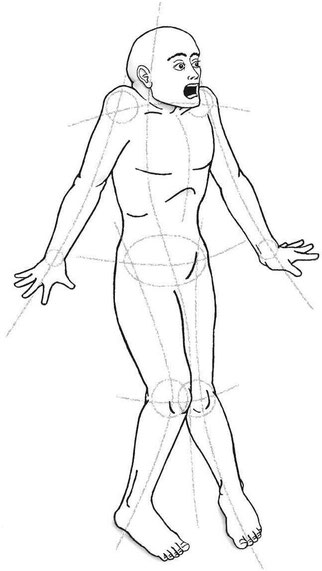DEFINING THE ALEXANDER TECHNIQUE Tim Soar © 1999
5. The Startle Pattern and the Importance of the Relationship Between the Head, Neck and Back

The startle pattern is the typical response of a person who is suddenly “made to jump”l. It follows a very specific pattern which is remarkably similar from person to person and does not show significant cultural variation: the muscles of the neck contract, pulling the head back and jamming it down onto the spine. This has a knock-on effect throughout the spine, causing the entire back to shorten. The ribs and shoulders, deprived of a lengthening spine to support them, tighten and narrow – the shoulders lifting, the arms locking straight and the chest flattening. The legs flex and the knees pull towards each other (the “knocking knees” of fear).
This sequence is completed in about half a second2. If the stimulus for the startle is not strong enough to elicit a whole-body response, the reaction may occur only in the neck muscles, without radiating to the rest of the body. Faced with a strong stimulus, a trained subject may succeed in inhibiting the tightening of the neck muscles and thus prevent a whole-body reaction.
An understanding of the startle pattern is invaluable to the Alexander student because it represents the antithesis of the desired relationship between the head, neck and back: Neck Free (not stiff), Head Forward and Up (not back and down), Back Lengthening and Widening (not shortening and narrowing).
After a little practice it is easy to observe that most people’s habitual way of moving seems to resemble a permanent, idiosyncratically modified startle pattern which clearly interferes with their ability to move, breathe, think or feel in an alert, integrated, healthy way.
In a well coordinated human the head, neck and back form a central axis which supports and integrates every aspect of her behaviour.
Quite simply, if the head, neck and back are well organised, one’s actions tend to reflect one’s intentions, large movements are powerful and harmonious, and small, localised
movements (like writing) can be made precisely whilst maintaining balance and integrity throughout the body. Without the regulating influence of this structural core our actions become inevitably disconnected and misdirected.
So if you want to allow your leg to be free-moving when your Alexander teacher moves it in a lesson, or if you would like to swim or run or cycle better, or if you need to make a difficult decision without stress or anxiety clouding your judgement, or if your ambition is to fill an opera house with your singing, or simply to survive a day at work without feeling as if you've been fed through a mangle, then:
learn to give priority to the relationship between your head, neck and back.
1 The so called “fight or flight” response involves a complex physiological chain of events, including changes in muscle tension, blood circulation, adrenaline levels, breathing, sweat gland activity, the digestive system and so on. I shall confine my use of the phrase “startle pattern” specifically to the postural changes associated typically with a loud, sudden noise. The extent to which the startle pattern serves any useful purpose in a dangerous situation remains a matter of conjecture. It has been shown, in certain circumstances, to improve reaction time, but on the other hand, many aspects of the startle pattern suggest simply a sudden “over-loading” of the neuromuscular system.
2 Freedom to Change, Frank Pierce Jones, 1976, Chapter 12 “Experimental Studies”.